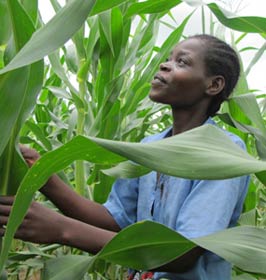
Malawian farmer happy to be part of SIMLESA
 Violet Chiwanda, (right picture) is a small-scale farmer in Salima, Central Malawi, who is participating in SIMLESA. She is a young woman, aged 25 years, with a farm of 0.25 ha. “I am happy to be involved in the SIMLESA project”, she says. “What I like most about this project is Conservation Agriculture (CA), a farming method that is less tedious and this gives me time to attend to other household chores.” She continues, “I know that conservation agriculture (CA) will lead to an increase in soil fertility”. However, she admits that initial collection of residue to be left on the ground was time-consuming, and also the fact light weeding has to be done all the time. Project treatments are carried out on plots of 20m x 18m. Violet is a good farmer, with over 15 years of experience, and can anticipate what kind of yield she can expect from the crop she has grown. She started a small grocery shop at her house using proceeds from the farm, and can easily provide for her two young children. “My neighbors are impressed by the work that I do and would like to take up the new technologies”, she adds. She explains to them what the project is about and shows them what she has done. Her best results from the trials are in a CA plot with sole maize, planted with a dibble stick. She likes this plot because the maize (variety MH27) has a good stand with large cobs.
Violet Chiwanda, (right picture) is a small-scale farmer in Salima, Central Malawi, who is participating in SIMLESA. She is a young woman, aged 25 years, with a farm of 0.25 ha. “I am happy to be involved in the SIMLESA project”, she says. “What I like most about this project is Conservation Agriculture (CA), a farming method that is less tedious and this gives me time to attend to other household chores.” She continues, “I know that conservation agriculture (CA) will lead to an increase in soil fertility”. However, she admits that initial collection of residue to be left on the ground was time-consuming, and also the fact light weeding has to be done all the time. Project treatments are carried out on plots of 20m x 18m. Violet is a good farmer, with over 15 years of experience, and can anticipate what kind of yield she can expect from the crop she has grown. She started a small grocery shop at her house using proceeds from the farm, and can easily provide for her two young children. “My neighbors are impressed by the work that I do and would like to take up the new technologies”, she adds. She explains to them what the project is about and shows them what she has done. Her best results from the trials are in a CA plot with sole maize, planted with a dibble stick. She likes this plot because the maize (variety MH27) has a good stand with large cobs.
Msamati Rashidi and Rashidi Makoloni are also a happy couple. They work their land together, and can compare techniques that they used prior to their involvement in the SIMLESA project. In this area of Salima, land belongs to women. Msamati likes farming because it is from this that she gets her daily needs catered for. Her total land covers an area of 0.7ha.”I would like to meet farmers from other regions to see how their trials are running”, she says. She feels that CA is an advantage due to reduced weeding resulting from the use of herbicides. Msamati also grows cotton and tobacco as cash crops, in addition to the small business that she runs from her house. Apart from helping on the farm, Msamati’s husband Rashidi is also a fisherman, and she helps sells his catch in her shop. According to them, the sowing of trials is easier work because of dibble planting. Referring to her CA plots, Msamati asserts, “If the rains do not fail, I hope to have a higher yield than before”.
The crop tended to look yellower in some CA plots with residues than in conventional farmer plots in this area. Isaiah Nyagumbo, SIMLESA’s Cropping Systems Agronomist for Southern Africa explains, “Under CA, there is initial immobilization of nutrients which reduces the amount of nitrogen taken up by the crop, yet in the farmer practice, the turning over of the soil results in higher nutrient mineralization . However, this is at the expense of soil quality as this oxidizes the soil organic carbon. Experience shows that CA plots progressively improve and catch up over time.”